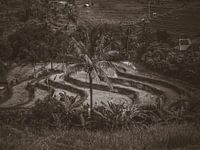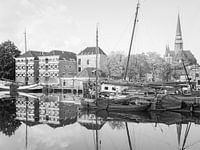Buy the photo Goa Gajah Bali Indonesia by Bianca Hinnen on canvas, ArtFrame, poster and wallpaper, printed on demand in high quality.
About "Goa Gajah Bali Indonesia"
by Bianca Hinnen
About the artwork
Goa Gajah, or Elephant Cave, is located on the island of Bali near Ubud, in Indonesia. Built in the 9th century, it served as a sanctuary.
The complex contains both Hindu and Buddhist imagery, as the cave contains lingam and yoni, symbol of Shiva, and the image of Ganesha, while by the river there are carved images of stupas and chattra, imagery of Buddhism.
The cave was rediscovered by Dutch archaeologists in 1923, but the fountains and bathing pool were not discovered until 1954.
The History of Goa Gajah
Goa Gajah is thought to date back to the 11th century, although relics predating this time were found within proximity of the site. The first mention of Goa Gajah and the Elephant Cave was in the Javanese poem Desawarnana written in 1365.
Despite the ancient significance of the Elephant Cave, the last excavation took place during the 1950s; many sites still remain unexplored. Literal piles of relics with unknown origins have been laid out in a surrounding garden.
The leading theory suggests that Goa Gajah was used as a hermitage or sanctuary by Hindu priests who dug the cave entirely by hand. Although accredited as a sacred Hindu site (one of many Hindu temples around Bali), a number of relics and the close proximity of a Buddhist temple suggest that the site held special significance to early Buddhists in Bali.

About Bianca Hinnen
Photography is capturing a snapshot that will not come back.
With an eye for detail, beauty, simplicity and colour.
I would like to share these snapshots with you...
Read more…
 Germany
Germany Ordered in June 2021
Ordered in June 2021
 Netherlands
Netherlands Ordered in January 2023
Ordered in January 2023
 Netherlands
Netherlands Ordered in February 2019
Ordered in February 2019
 Netherlands
Netherlands Ordered in August 2018
Ordered in August 2018

 Netherlands
Netherlands Ordered in November 2020
Ordered in November 2020
 Germany
Germany Ordered in October 2019
Ordered in October 2019
 Germany
Germany Ordered in June 2025
Ordered in June 2025
 Netherlands
Netherlands Ordered in July 2019
Ordered in July 2019
 Netherlands
Netherlands Ordered in October 2020
Ordered in October 2020
 Netherlands
Netherlands Ordered in December 2018
Ordered in December 2018
 Netherlands
Netherlands Ordered in May 2020
Ordered in May 2020
 Netherlands
Netherlands Ordered in January 2019
Ordered in January 2019

About the material
ArtFrame™
Interchangeable Art Prints
- High-quality print
- Easily interchangeable
- Acoustic function
- Large sizes available
Discover the artworks of Bianca Hinnen
 Paris Le MetroBianca Hinnen
Paris Le MetroBianca Hinnen Historic street in AmersfoortBianca Hinnen
Historic street in AmersfoortBianca Hinnen MuurhuizenBianca Hinnen
MuurhuizenBianca Hinnen View over the rice fields in Bali IndonesiaBianca Hinnen
View over the rice fields in Bali IndonesiaBianca Hinnen 'Canang sari'Bianca Hinnen
'Canang sari'Bianca Hinnen Canang sariBianca Hinnen
Canang sariBianca Hinnen IguanasBianca Hinnen
IguanasBianca Hinnen GoudaBianca Hinnen
GoudaBianca Hinnen De Zwaan RotterdamBianca Hinnen
De Zwaan RotterdamBianca Hinnen Landschaftspark DuisburgBianca Hinnen
Landschaftspark DuisburgBianca Hinnen St John's Cathedral Den Bosch 's-HertogenboschBianca Hinnen
St John's Cathedral Den Bosch 's-HertogenboschBianca Hinnen St John's Cathedral Den Bosch 's-HertogenboschBianca Hinnen
St John's Cathedral Den Bosch 's-HertogenboschBianca Hinnen ValenciaBianca Hinnen
ValenciaBianca Hinnen deerBianca Hinnen
deerBianca Hinnen ScotlandBianca Hinnen
ScotlandBianca Hinnen ScotlandBianca Hinnen
ScotlandBianca Hinnen India AlmeloBianca Hinnen
India AlmeloBianca Hinnen India AlmeloBianca Hinnen
India AlmeloBianca Hinnen India AlmeloBianca Hinnen
India AlmeloBianca Hinnen Tropea Costa degli DeiBianca Hinnen
Tropea Costa degli DeiBianca Hinnen













 Bali
Bali Indonesia
Indonesia Mysterious Spheres
Mysterious Spheres Photo wallpaper
Photo wallpaper Photography
Photography UNESCO World Heritage Locations
UNESCO World Heritage Locations









